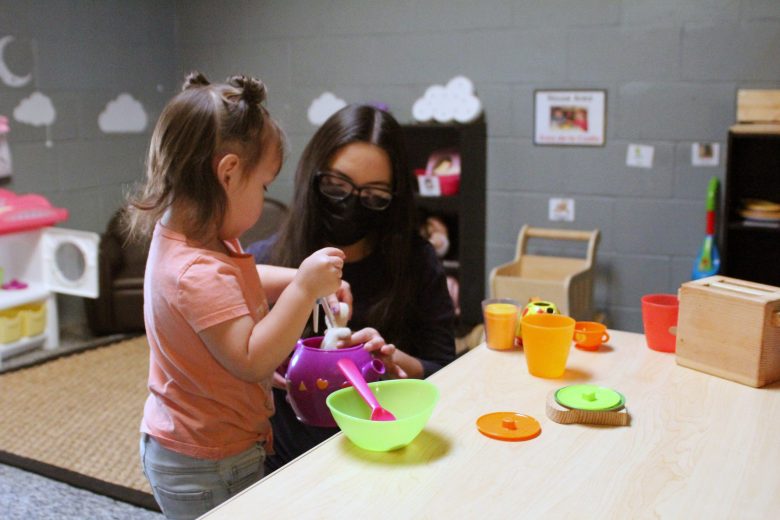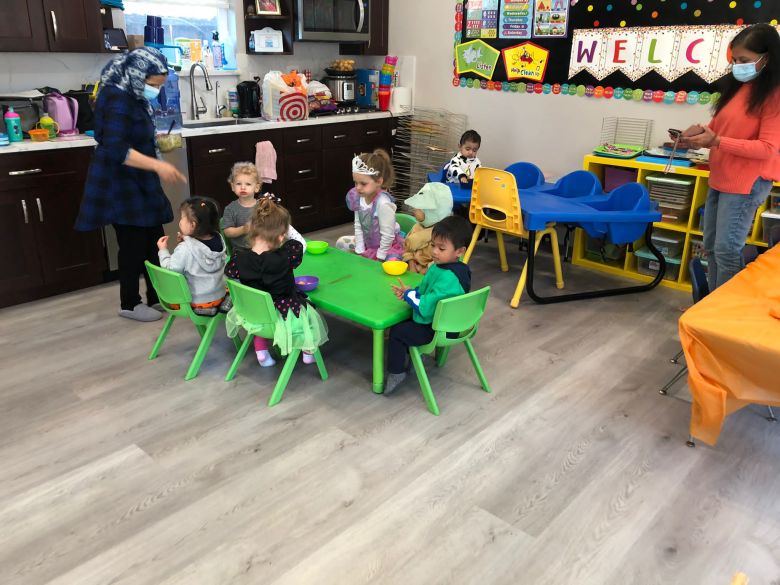At Aliya Johnson Roberts’ two child care centers in Philadelphia, many employees aren’t done working when they clock out at the end of a long day nurturing and teaching young kids. Instead of heading home, they leave for second jobs, often as home health aides. The grueling schedule is necessary: Without the extra work, they can’t make enough money to cover their basic needs, Johnson Roberts said. She wants to pay her teachers more, but is stymied by the same issue plaguing child care providers nationwide: A staff shortage. She can’t find enough teachers to open up all the classrooms in her two centers, which means there’s not enough money coming in to substantially boost salaries.
Rochelle Wilcox, in New Orleans, said her employees face a similar situation. She estimates that up to 50 percent of her staff members are working a second job to make ends meet — driving for Uber, delivering groceries, and pulling overnight shifts at local hotels. As owner of the child care center, Wilcox isn’t much better off. For years, she wasn’t even making enough money to pay herself.
Over the last 18 months, the nation has come to understand how fractured and broken its child care system truly is. Now, a recently released report is shedding light on the plight of child care workers, whose well-being hangs in balance as Congress considers legislation that could boost the industry. These workers are experiencing pronounced difficulties paying for basic needs, according to the report released by the University of Oregon’s RAPID-EC project, a bi-weekly survey that has been tracking the experiences of caregivers and families with young children during the pandemic.
Food insecurity was an issue for 23 percent of child care providers pre-pandemic, that percentage rose to an average of 29 percent between February and July 2021, according to the report. The situation is even more dire for teachers at child care centers, 44 percent of whom reported experiencing hunger during the pandemic. Some 34 percent of individuals watching the children of friends, family or neighbors reported experiencing food insecurity, along with 26 percent of home-based providers and 14 percent of child care center directors. Providers are also reporting marked levels of anxiety, stress and depression, in part due to the low pay and unpredictable nature of their jobs.

Even before the pandemic, many providers struggled to meet basic needs. Child care workers make, on average, less than $14 an hour, according to the Economic Policy Institute, far less than they can earn working at Target, Starbucks or in many fast food restaurants. Workers also tend to lack benefits like health insurance, family leave and paid sick leave.
In Salisbury, Maryland, Cherry Conley works between 65 and 70 hours a week planning lessons, teaching, cleaning and cooking meals for the young children she watches at her home-based child care, which she opened in 1992. After taxes, she makes about $10,000 a year, several thousand dollars below the poverty level for a single-person household. She said she only survived the economic impact of pandemic because her 26-year-old daughter’s family moved in with her, providing another income stream and some free help with her business.
The fact that society is “expecting nurturing, responsive care,” from providers who don’t have enough money to put food on the table, “is really unconscionable,” said Phil Fisher, a psychology professor at the University of Oregon and director of the RAPID-EC project. As a society, we’re overlooking our “moral obligation” to these workers, he said.
The economic challenges of child care workers go beyond food insecurity. More than 10 percent of center-based teachers surveyed for the report said they were evicted during the pandemic, and more than 25 percent said they could not fully pay their gas, oil or electricity bills. Nearly 30 percent said they struggled to keep up with rent or mortgage payments. Overall, one in four child care providers has at least one other job to make ends meet; and for more than 40 percent of survey respondents, earnings from child care accounted for less than half of their total income. “We have our most vulnerable population taking care of our most vulnerable population,” said Libbie Sonnier, executive director of The Louisiana Policy Institute for Children. “You have child care teachers that are working long, hard hours with our most precious commodity but they’re worrying about keeping a roof over their head and how they feed their own children.”
These experiences have had a deep impact on the well-being of early childhood teachers. The report found that food insecurity among child care employees was especially likely to contribute to an increase in emotional distress. “It’s just a very clear pattern,” said Fisher. “If you don’t have any issue around food insecurity, then you’re much better off. As you start having difficulties, when you’re cutting back on meals, feeding your kids before yourself … we see an increase in emotional distress,” he said.
The weight of the job became especially challenging during the pandemic, compounding the personal stress many child care workers were already experiencing, said Lisa Herbst, who owns two child care centers in Maryland. “Being responsible for the health, safety, welfare and education of children has been incredibly stressful,” Herbst said. “It’s always a heavy responsibility, but it became even more so during the pandemic.
The many changes related to the pandemic disrupted providers’ emotional well-being, said Shruti Agarwal, who owns a home-based child care program in Livermore, California. In addition to adjusting to providing school-age care for children participating in distance learning and worrying about children spreading Covid-19 to each other, Agarwal had to dip into savings to pay her one full-time employee at the center. “There was anxiety, there were phases when you were depressed, because you were doing so much for everybody else and not doing so much for your own self,” she said.

Advocates and experts say the best hope to improve the well-being of child care workers and lift up the industry is through an infusion of federal funds. In his Build Back Better agenda, President Joe Biden has proposed a host of child care investments, including raising the minimum wage for early childhood staff to $15 an hour and providing funding for states to expand high quality child care and improve child care facilities. The plan would also subsidize the cost of child care for more families and substantially increase the number of child care jobs. It’s one of the largest efforts to reform child care on a national scale, but members of Congress are still debating which elements of the plan will move forward.
The problems with America’s child care model have existed for years; care is expensive, especially for the youngest children, and high-quality care is even more expensive. Many parents can’t afford the true cost of child care, which runs more than $1,300 a month, on average, for an infant and nearly $900 a month for a preschooler. Even when states subsidize child care for low-income families, they don’t fully reimburse providers for the actual cost of that care — as much as almost $29,000 a year for an infant. That leaves either families or providers to make up the difference. After paying for the cost of the building, employees, supplies and food and educational materials, owners of child care centers are left with little to nothing. That’s why many child care workers live in poverty. “We’re in a crisis situation that can’t be fixed through the free market,” Fisher said. “Until the government can help support the cost of child care, the system can’t pay for itself.”
Research shows that giving more money to child care workers could help stabilize the workforce, possibly helping to ease the crisis. A report from the University of Virginia found that turnover was lower among early educators who received a $1,500 payment as part of a pilot program funded by the state. An educator’s wage was the strongest predictor of staff turnover in early childhood centers, regardless of whether benefits or other incentives were given to providers, according to a 2021 report released by the National Center for Education Evaluation and Regional Assistance at the federal Institute of Education Sciences.
“There were no factors apart from wages that matter for keeping early childhood educators in their job,” said Meg Caven, senior research associate at the Education Development Center. “It didn’t really matter, across regions, whether they had health and retirement benefits, whether they had paid time off … it really all came down to the money.”
Herbst, in Maryland, has seen the immense impact of raising salaries. In August, when she had no qualified applicants for 14 new staff positions, Herbst increased her pay scale by 20 percent, and started offering $22 an hour. “We had to, because people could go to Kohl’s or people could go to McDonald’s or they could go to Sam’s Club [for jobs],” she said. “We were competing for the few people that are able to work.”
In the first three weeks of August, Herbst received 300 applications for the 14 positions and filled every position. She doesn’t know how long she’ll be able to sustain the higher salaries, however, and ultimately wants to be able to pay employees what she thinks they deserve: the same salary as a public-school teacher. She said it is critical, considering the requirements of the job. “This is highly, highly skilled work,” Herbst said. “It requires being aware of growth and development, it requires being aware of social and emotional development, cognitive development, and physical development … it requires having a lot of physical energy and stamina.”

More funding would help professionalize the industry. “We’ve been disrespected for years,” said Conley, the caregiver in Maryland. “We’ve been put down and disrespected, and culture as a whole teaches parents that we’re babysitters.”
Wilcox, in New Orleans, said her teachers don’t dream of a life of luxury — just a living wage. Providing that would give child care employees the stability they deserve. “They want to be able to buy a home, they want to be able to have a reliable car, they want to be able to take their family on vacation. Isn’t that the American dream?” said Wilcox. “We have our youngest, most vulnerable learners at the most important time,” she added. “Why are teachers and directors not afforded the American dream when we are doing the most essential work?”
Editor’s note: This story led off this week’s Early Childhood newsletter, which is delivered free to subscribers’ inboxes every other Wednesday with trends and top stories about early learning. Subscribe today!
This story about food insecurity was produced by The Hechinger Report, a nonprofit, independent news organization focused on inequality and innovation in education. Sign up for the Hechinger newsletter.




I happened upon a study (titled ‘The Science of Early Childhood Development’, 2007) that formally discovered what I feel should have been the obvious. The following quoted text was taken from the study’s 13-page report: “The future of any society depends on its ability to foster the health and well-being of the next generation. Stated simply, today’s children will become tomorrow’s citizens, workers, and parents. When we invest wisely in children and families, the next generation will pay that back through a lifetime of productivity and responsible citizenship. When we fail to provide children with what they need to build a strong foundation for healthy and productive lives, we put our future prosperity and security at risk … All aspects of adult human capital, from work force skills to cooperative and lawful behavior, build on capacities that are developed during childhood, beginning at birth … The basic principles of neuroscience and the process of human skill formation indicate that early intervention for the most vulnerable children will generate the greatest payback.”
In the report’s entirety, the term “investment(s)” was used 22 times, “return” appeared eight times, “cost(s)” five times, “capital” appeared on four occasions, and either “pay”/“payback”/“pay that back” was used five times. I strongly feel, however, that human health or lives should not be treated like monetary/material investments.